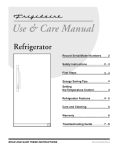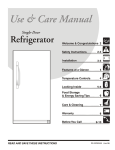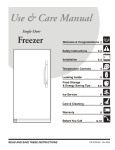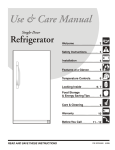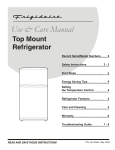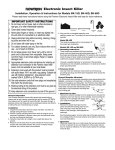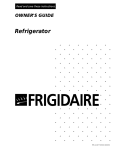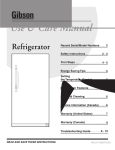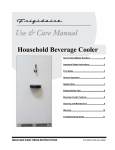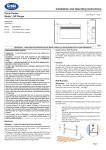Download Frigidaire 297081000 Refrigerator User Manual
Transcript
Use & Care Manual Refrigerador Record Serial/Model Numbers Safety Instructions 2-3 First Steps 3-4 Energy Saving Tips 4 Setting the Temperature Control 4 Refrigerator Features 4-5 Care and Cleaning 5 Warranty 6 Troubleshooting Guide READ AND SAVE THESE INSTRUCTIONS 2 7-8 P/N 297081000 (Jan 2000) CHILD SAFETY SERIAL / MODEL NUMBERS • Destroy carton, plastic bags, and any exterior wrapping material immediately after the refrigerator is unpacked. Children should never use these items to play. Cartons covered with rugs, bedspreads, plastic sheets or stretch wrap may become airtight chambers, and can quickly cause suffocation. READ AND SAVE THESE INSTRUCTIONS This Owner’s Guide provides specific operating instructions for your model. Use your refrigerator only as instructed in this guide. These instructions are not meant to cover every possible condition and situation that may occur. Common sense and caution must be practiced when installing, operating, and maintaining any appliance. • Remove all staples from the carton. Staples can cause severe cuts, and destroy finishes if they come in contact with other appliances or furniture. Record Your Model and Serial Numbers • An empty, discarded ice box, refrigerator, or freezer is a very dangerous attraction to children. Record the model and serial numbers in the space provided below. The serial plate is located on the upper left wall inside the refrigerator. • Remove and discard any spacers used to secure the shelves during shipping. Small objects are a choke hazard to children. Model Number: Serial Number: Remove the door(s) of any appliance that is not in use, even if it is being discarded. Purchase Date: Proper Disposal of Your Refrigerator/Freezer Risk of child entrapment. Child entrapment and suffocation are not problems of the past. Junked or abandoned refrigerators or freezers are still dangerous — even if they will sit for "just a few days." If you are getting rid of your old refrigerator or freezer, please follow the instructions below to help prevent accidents. BEFORE YOU THROW AWAY YOUR OLD REFRIGERATOR/FREEZER: Versión en español Si desea obtener una copia en español de este Manual del Usuario, sívase escribir a la dirección que se incluye a continuación. Solicite la P/N 297081100. • Remove doors. • Leave shelves in place so children may not easily climb inside. Spanish Owner’s Guides Electrolux Home Products P.O. Box 212378 Augusta, GA 30917 ELECTRICAL INFORMATION These guidelines must be followed to ensure that safety mechanisms in the design of this refrigerator will operate properly. IMPORTANT SAFETY INSTRUCTIONS READ ALL INSTRUCTIONS BEFORE USING THIS REFRIGERATOR. FOR YOUR SAFETY Do not store or use gasoline, or other flammable vapors and liquids in the vicinity of this or any other appliance. Read product labels for flammability and other warnings. 2 • Refrigerator must be plugged into its own 115 Volt, 60 Hz., AC only electric outlet. The power cord of the appliance is equipped with a three-prong grounding plug for your protection against shock hazards. It must be plugged directly into a properly grounded threeprong receptacle. The receptacle must be installed in accordance with local codes and ordinances. Consult a qualified electrician. Do not use an extension cord or adapter plug. • Allow space around the unit for good air circulation. Leave a 3 inch (75 mm) space on all sides of the refrigerator for adequate circulation. • If voltage varies by 10% or more, performance of your refrigerator may be affected. Operating refrigerator with insufficient power can damage the compressor. • To prevent the refrigerator from being turned off accidentically, do not plug unit into an outlet controlled by a wall switch or pull cord. • Do not pinch, knot, or bend the cord in any manner. OTHER PRECAUTIONS • Never unplug the refrigerator by pulling on the cord. Always grip the plug firmly, and pull straight out from the receptacle. • To avoid electrical shock, unplug the refrigerator before cleaning and before replacing a light bulb. NOTE: Turning the temperature control to OFF turns off the compressor, but does not disconnect the power to the light bulb or other electrical components. Installation • Do not operate refrigerator in the presence of explosive fumes. NOTE: The exterior walls of the refrigerator may become quite warm as the compressor works to transfer heat from the inside. Temperatures as much as 30° F warmer than room temperature can be expected. For this reason it is particularly important in hotter climates to allow enough space for air circulation around your refrigerator. Avoid fire hazard or electric shock. Do not use an extension cord or an adapter plug. Do not remove any prong from the power cord. LEVELING The refrigerator must have all bottom corners resting firmly on a solid floor. The floor must be strong enough to support a fully loaded refrigerator. NOTE: It is Very Important for your refrigerator to be level in order to function properly. If the refrigerator is not leveled during installation, the door may be misaligned and not close or seal properly, causing cooling, frost, or moisture problems. To Level Your Refrigerator: After discarding crating screws and wood base, use a carpenter’s level to level the refrigerator from front-to-back. Adjust the plastic leveling feet in front, ½ bubble higher, so that the door closes easily when left halfway open. FIRST STEPS This Owner’s Guide provides specific operating instructions for your model. Use the refrigerator only as instructed in this Owner’s Guide. Before starting the refrigerator, follow these important first steps. INSTALLATION • Choose a place that is near a grounded electrical outlet. Do Not use an extension cord or an adapter plug. • For the most efficient operation, the refrigerator should be located where surrounding temperatures will not drop below 10° F (-12° C) or exceed 110° F (43° C). The Freeze Control Feature is designed to automatically maintain the selected interior refrigerator temperature within these boundaries. Unpacking and Leveling 3 • Cover foods and wipe containers dry before placing them in the refrigerator. This cuts down on moisture build-up inside the unit. • Organize the refrigerator to reduce door openings. Remove as many items as needed at one time and close the door as soon as possible. CLEANING • Wash any removable parts of the refrigerator interior, and exterior with mild detergent and warm water. Wipe dry. Do not use harsh cleaners on these surfaces. • Do not use razor blades or other sharp instruments, which can scratch the appliance surface when removing adhesive labels. Any glue left from the tape can be removed with a mixture of warm water and mild detergent, or touch the residue with the sticky side of tape already removed. Do not remove the serial plate. SETTING THE TEMPERATURE CONTROL COOL DOWN PERIOD For safe food storage, allow 4 hours for the refrigerator to cool down completely. The refrigerator will run continuously for the first several hours. TEMPERATURE CONTROL The temperature control is located inside the refrigerator. The temperature is factory preset to provide satisfactory food storage temperatures. However, the temperature control is adjustable to provide a range of temperatures for your personal satisfaction. If a colder temperature is desired, turn the temperature control knob toward COLDEST and allow several hours for temperatures to stabilize between adjustments. DOOR REMOVAL If door must be removed : 1. Gently lay refrigerator on its back, on a rug or blanket. 2. Remove two base screws and base panel. Remove wire clips on bottom of cabinet. 3. Remove bottom hinge screws. 4. Remove plastic top hinge cover. 5. Remove screws from top hinge. 6. Remove top hinge from cabinet. 7. Remove door and bottom hinge from cabinet. 8. To replace door, reverse the above order and securely tighten all screws to prevent hinge slippage. Cold Control REFRIGERATOR FEATURES TILT-OUT SHELF This shelf is located inside on the refrigerator door and provides additional storage space. To access an item, tilt top of “basket” shelf down. ENERGY SAVING TIPS • Install the refrigerator in the coolest part of the room, out of direct sunlight and away from heating ducts or registers. Do not place the refrigerator next to heat- producing appliances such as a range, oven or dishwasher. • Level the refrigerator so the door close tightly. • Do not overcrowd the refrigerator or block cold air vents. Doing so causes the refrigerator to run longer and use more energy. Shelves should not be lined with aluminum foil, wax paper or paper toweling. Liners interfere with cold air circulation, making the refrigerator less efficient, which could cause food spoilage. 4 ADJUSTABLE INTERIOR SHELVES CARE AND CLEANING Multi-position adjustable interior shelves can be moved to any position for larger or smaller packages. The shipping spacers that stabilize the shelves for shipping should be removed and discarded. CLEANING THE INSIDE Wash inside surfaces of the refrigerator with a solution of two tablespoons of baking soda in one quart (1.136 litres) warm water. Rinse and dry. Wring excess water out of the sponge or cloth when cleaning in the area of the controls, or any electrical parts. Wash the removable parts with the baking soda solution mentioned above, or mild detergent and warm water. Rinse and dry. Never use metallic scouring pads, brushes, abrasive cleaners, or alkaline solutions on any surface. Do not wash removable parts in a dishwasher. CLEANING THE OUTSIDE Adjustable Interior Shelves Wash the cabinet with warm water and mild liquid detergent. Rinse well and wipe dry with a clean soft cloth. Replace parts and food. WARNING If leaving the refrigerator door open while on vacation, make certain that children cannot get into the refrigerator and become entrapped. VACATION AND MOVING TIPS Vacations: If the refrigerator will not be used for several months: Adjustable Interior Shelves and Slide-Out Basket • Remove all food and unplug the power cord. SLIDE-OUT BASKET • Clean and dry the interior thoroughly. A Slide-Out Basket (some models) located at the bottom of the refrigerator, provides separate storage space for items that are difficult to store on refrigerator shelves. To remove the basket, pull out and lift up. • Leave the refrigerator door open slightly, blocking it open if necessary, to prevent odor and mold growth. AUTOMATIC FREEZE CONTROL • Disconnect the power cord plug from the wall outlet. Moving: When moving the refrigerator, follow these guidelines to prevent damage: • Remove foods and clean the refrigerator. The Freeze Control Feature will maintain proper interior refrigerator temperature even when the refrigerator is placed in an area where the surrounding temperature drops down to 10° F (-12° C). • Secure all loose items by taping them securely in place to prevent damage. • In the moving vehicle, secure refrigerator in an upright position to prevent movement. Also protect outside of refrigerator with a blanket, or similar item. INTERIOR LIGHT The light comes on automatically when the door is opened. To replace the light bulb, turn the temperature control to OFF and unplug the electrical cord. Replace the old bulb with a bulb of the same wattage. 5 Major Appliance Warranty Information Your appliance is covered by a one year limited warranty. For one year from your original date of purchase, Electrolux will pay all costs for repairing or replacing any parts of this appliance that prove to be defective in materials or workmanship when such appliance is installed, used and maintained in accordance with the provided instructions. Exclusions This warranty does not cover the following: 1. Products with original serial numbers that have been removed, altered or cannot be readily determined. 2. Product that has been transferred from its original owner to another party or removed outside the USA or Canada. 3. Rust on the interior or exterior of the unit. 4. Products purchased "as-is" are not covered by this warranty. 5. Food loss due to any refrigerator or freezer failures. 6. Products used in a commercial setting. 7. Service calls which do not involve malfunction or defects in materials or workmanship, or for appliances not in ordinary household use or used other than in accordance with the provided instructions. 8. Service calls to correct the installation of your appliance or to instruct you how to use your appliance. 9. Expenses for making the appliance accessible for servicing, such as removal of trim, cupboards, shelves, etc.,which are not a part of the appliance when it is shipped from the factory. 10. Service calls to repair or replace appliance light bulbs, air filters, water filters, other consumables, or knobs, handles, or other cosmetic parts. 11. Surcharges including, but not limited to, any after hour, weekend, or holiday service calls, tolls, ferry trip charges, or mileage expense for service calls to remote areas, including the state of Alaska. 12. Damages to the finish of appliance or home incurred during installation, including but not limited to floors, cabinets, walls, etc. 13. Damages caused by: services performed by unauthorized service companies; use of parts other than genuine Electrolux parts or parts obtained from persons other than authorized service companies; or external causes such as abuse, misuse, inadequate power supply, accidents, fires, or acts of God. DISCLAIMER OF IMPLIED WARRANTIES; LIMITATION OF REMEDIES CUSTOMER’S SOLE AND EXCLUSIVE REMEDY UNDER THIS LIMITED WARRANTY SHALL BE PRODUCT REPAIR OR REPLACEMENT AS PROVIDED HEREIN. CLAIMS BASED ON IMPLIED WARRANTIES, INCLUDING WARRANTIES OF MERCHANTABILITY OR FITNESS FOR A PARTICULAR PURPOSE, ARE LIMITED TO ONE YEAR OR THE SHORTEST PERIOD ALLOWED BY LAW, BUT NOT LESS THAN ONE YEAR. ELECTROLUX SHALL NOT BE LIABLE FOR CONSEQUENTIAL OR INCIDENTAL DAMAGES SUCH AS PROPERTY DAMAGE AND INCIDENTAL EXPENSES RESULTING FROM ANY BREACH OF THIS WRITTEN LIMITED WARRANTY OR ANY IMPLIED WARRANTY. SOME STATES AND PROVINCES DO NOT ALLOW THE EXCLUSION OR LIMITATION OF INCIDENTAL OR CONSEQUENTIAL DAMAGES, OR LIMITATIONS ON THE DURATION OF IMPLIED WARRANTIES, SO THESE LIMITATIONS OR EXCLUSIONS MAY NOT APPLY TO YOU. THIS WRITTEN WARRANTY GIVES YOU SPECIFIC LEGAL RIGHTS. YOU MAY ALSO HAVE OTHER RIGHTS THAT VARY FROM STATE TO STATE. If You Need Service Keep your receipt, delivery slip, or some other appropriate payment record to establish the warranty period should service be required. If service is performed, it is in your best interest to obtain and keep all receipts. Service under this warranty must be obtained by contacting Electrolux at the addresses or phone numbers below. This warranty only applies in the USA and Canada. In the USA, your appliance is warranted by Electrolux Major Appliances North America, a division of Electrolux Home Products, Inc. In Canada, your appliance is warranted by Electrolux Canada Corp. Electrolux authorizes no person to change or add to any obligations under this warranty. Obligations for service and parts under this warranty must be performed by Electrolux or an authorized service company. Product features or specifications as described or illustrated are subject to change without notice. USA 1.800.944.9044 Electrolux Major Appliances North America P.O. Box 212378 Augusta, GA 30907 Canada 1.800.668.4606 Electrolux Canada Corp. 5855 Terry Fox Way Mississauga, Ontario, Canada L5V 3E4 6 TROUBLESHOOTING GUIDE PROBLEM Before calling for service, review this list. It may save you time and expense. This list includes common occurences that are not the result of defective workmanship or materials in this appliance. CAUSE CORRECTION • Refrigerator is plugged into a circuit that has a ground fault interrupt. • Temperature control is in the OFF position. • Refrigerator may not be plugged in, or plug may be loose. • House fuse blown or tripped circuit breaker. • Power outage. • Use another circuit. If you are unsure about the outlet,have it checked by a certified technician. REFRIGERATOR OPERATION Refrigerator does not run. Refrigerator runs too much or too long. • Room or outside weather is hot. • Refrigerator has recently been disconnected for a period of time. • Large amounts of warm or hot food have been stored recently. • Doors are opened too frequently or too long. • Refrigerator door may be slightly open. • Temperature Control is set too low. • Refrigerator gasket is dirty, worn, cracked, or poorly fitted. • See Setting the Temperature Control Section. • Ensure plug is tightly pushed into outlet. • Check/replace fuse with a 15 amp time-delay fuse. Reset circuit breaker. • Check house lights. Call local Electric Company. • It's normal for the refrigerator to work harder under these conditions. • It takes 4 hours for the refrigerator to cool down completely. • Warm food will cause refrigerator to run more until the desired temperature is reached. • Warm air entering the refrigerator causes it to run more. Open doors less often. • See "DOOR PROBLEMS" Section. • Turn control knob to a warmer setting. Allow several hours for the temperature to stabilize. • Clean or change gasket. Leaks in the door seal will cause refrigerator to run longer in order to maintain desired temperature. Interior refrigerator temperature is too cold. • Temperature Control is set too low. • Turn the control to a warmer setting. Allow several hours for the temperature to stabilize. Interior refrigerator temperature is too warm. • Temperature Control is set too warm. • Door is kept open too long or is opened too frequently. • Door may not be seating properly. • Large amounts of warm or hot food may have been stored recently. • Refrigerator has recently been disconnected for a period of time. • Turn control to a colder setting. Allow several hours for the temperature to stabilize. • Warm air enters the refrigerator every time the door is opened. Open the door less often. • See "DOOR PROBLEMS" Section. • Wait until the refrigerator has had a chance to reach its selected temperature. • Refrigerator requires 4 hours to cool down completely. • The external refrigerator walls can be as much as 30°F warmer than room temperature. • This is normal while the compressor works to transfer heat from inside the refrigerator cabinet. Louder sound levels whenever refrigerator is on. • Modern refrigerators have increased storage capacity and more stable temperatures. They require a high efficiency compressor. • This is normal. When the surrounding noise level is low, you might hear the compressor running while it cools the interior. Longer sound levels when compressor comes on. • Refrigerator operates at higher pressures during the start of the ON cycle. • This is normal. Sound will level off or disappear as refrigerator continues to run. Refrigerator external surface temperature is warm. SOUND AND NOISE 7 PROBLEM CAUSE CORRECTION SOUND AND NOISE (Cont.) Fan runs when room temperature is below 45°F. • Exterior thermostat has activated the heater and fan. • This is normal. Popping or cracking sound when compressor comes on. • Metal parts undergo expansion and contraction, as in hot water pipes. • This is normal. Sound will level off or disappear as refrigerator continues to run. Bubbling or gurgling sound, like water boiling. • Refrigerant (used to cool refrigerator) is circulating throughout the system. • This is normal. Vibrating or rattling noise. • Refrigerator is not level. It rocks on the floor when it is moved slightly. • Refrigerator is touching the wall. • Level the unit. Refer to "Leveling" in the First Steps Section. • Cold Control turning the refrigerator on and off. • This is normal. Snapping Sound. • Relevel the refrigerator or move refrigerator slightly. Refer to "Leveling" in the First Steps Section. WATER/MOISTURE/FROST INSIDE REFRIGERATOR Moisture forms on inside of refrigerator walls. • Weather is hot and humid. • Door may not be seating properly. • Door is kept open too long, or is opened too frequently. • This is normal. • See "DOOR PROBLEMS" Section. • Open the door less often. WATER/MOISTURE/FROST OUTSIDE REFRIGERATOR Moisture forms on outside of refrigerator. • Door may not be seating properly, causing the cold air from inside the refrigerator to meet warm moist air from outside. • See "DOOR PROBLEMS" Section. • Interior needs to be cleaned. • Foods with strong odors are in the refrigerator. • Clean interior with sponge, warm water, and baking soda. • Cover the food tightly. • Refrigerator is not level. It rocks on the floor when it is moved slightly. • This condition can force the cabinet out of square and misalign the door. Refer to "Leveling" in the First Steps Section. • Light bulb is burned out. • Follow directions under "Interior Light" in the Refrigerator Features Section. • See "REFRIGERATOR OPERATION" Section. ODOR IN REFRIGERATOR Odors in refrigerator. DOOR PROBLEMS Door will not close. LIGHT BULB IS NOT ON Light bulb is not on. • No electric current is reaching the refrigerator. 8








